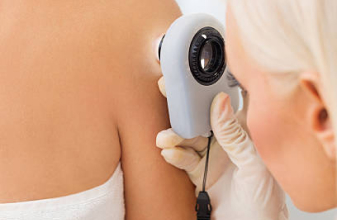
Melanoma (skin) cancer
Melanoma is a type of skin cancer. It can begin in either an existing mole or as a new growth on your skin. Melanocytes can become damaged (often by the sun) and grow abnormally. This can cause a cancerous tumor. If left untreated, the tumor can begin to grow deeper into your skin’s surface. When this happens, there is a chance it can spread to lymph nodes or other parts of your body.

Moles
A mole is a growth on your skin. Moles develop when pigment cells in your skin, called melanocytes, grow in a cluster with tissue around them. Moles are very common. You most likely have between 10 and 40 moles on your skin. You may notice new moles on your skin until about age 40.
Normal moles
Normal moles can be identified by...
- color: evenly tan or brown
- size: no larger than the eraser of a pencil (about 1/4 inch)
- shape: round or oval
- surface: either flat or raised
Many moles start small and flat and slowly grow in size, developing a raised surface. Over time (many years) they may flatten out, turn flesh-colored and disappear.
Unusual (atypical) moles
About 10 percent of the population has at least one mole that doesn’t look like normal moles. These kinds of moles are often called “dysplastic nevi.”
They can be identified by...
- color: a mix of tan, brown and red/pink
- size: often larger than 1/4-inch or 1/2-inch across
- shape: irregular, sometimes notched edges
- surface: may be smooth, scaly or pebbly
Dysplastic nevi are more likely than normal moles to develop into a type of skin cancer called melanoma. Melanoma can be fatal. Because of this, your health care provider should check any moles you have as part of your routine health care.
If a mole changes in size, color, shape or in any other way, you should have it checked.

Signs of melanoma
The most common sign of melanoma is a change in an existing mole. This may include the shape, color, size or feel. Melanoma can also appear as a new mole.
Using the “ABCDE” acronym will help you remember the signs of melanoma:
- Asymmetry. The shape of one side of the mole does not match the other side.
- Border. The edges of the mole may be irregular, ragged or blurred. The pigment (color) of the mole may blend in with the surrounding skin.
- Color. The color is not the same all over the mole. There may be shades of black, brown or tan. There may also be areas of white, blue, gray or red.
- Diameter. The mole has increased in size or is larger than the eraser of a pencil (about ¼ inch).
- Evolving. The mole has changed over the past few weeks or months.
A mole can show one or more of the signs listed above. If you have a question or concern about a mole, please call your health care provider.

Finding melanoma
If you have an abnormal-looking mole, your health care provider may order a biopsy of it. A biopsy removes the mole or a sample of tissue for testing under a microscope.
If you do have melanoma, you and your health care provider will work together to develop a treatment plan that is right for you.
Find a dermatologist or schedule an appointment with your primary care provider.

Preventing melanoma
Skin exams
Do skin self-exams on a regular basis:
- Check all of your skin in a mirror or have someone do it for you. Do not forget hard-to-see places such as your scalp and neck.
- Become familiar with how your moles look. If you see any change, contact your health care provider.
- Have your skin checked on a regular basis by your primary care provider or dermatologist.
Sun protection
You do not need to avoid the sun. A few easy actions on your part can help you safely enjoy outdoor activities and stay active.
- There is no such thing as a safe tan. Do not use tanning beds.
- Use sunscreen with an SPF of 30 or higher because it protects against 97 percent of UV rays.
- Wear protective clothing when you are in the sun such as a hat and long sleeves.
- Wear sunglasses with large lenses that fit close to your face. Look for sunglasses that block 99 to 100 percent of UVA and UVB rays.
- Use protective lip balm every day and reapply often.
- Try to limit your time out in the sun between 10 a.m. and 3 p.m.

Sunscreen tips
- Look for sunscreen labeled as broad spectrum or full spectrum because it protects against both types of UV rays.
- Apply sunscreen 15 to 20 minutes before going outside. Reapply sunscreen every 2 hours. You should also reapply sunscreen after sweating or leaving the water.
Want to know more?
Learn how Allina Health cares for melanoma skin cancer patients.
Explore our cancer resources
We created this collection of information and support to help you through this time.